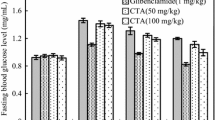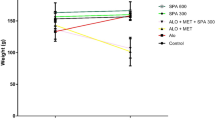Abstract
The aim of the present study was to evaluate the antihyperglycemic and antilipidperoxidative effects of ethanolic seed extract ofTephrosia purpurea (TpEt) in streptozotocin induced diabetic rats. Hyperglycemia associated with an altered hexokinase and glucose 6 phosphatase activities, elevated lipid peroxidation, disturbed enzymatic and non-enzymatic antioxidants status were observed in streptozotocin induced diabetic rats. Oral administration of “TpEt” at a dose of 300mg/kg bw showed significant antihyperglcemic and antilipidperoxidative effects as well as increased the activities of enzymatic antioxidants and levels of non enzymatic antioxidants. We also noticed that the antihyperglycemic effect of plant drug (TpEt) was comparable to that of the reference drug glibenclamide. Our results clearly indicate that “TpEt” has potent antihyperglycemic and antilipidperoxidative effects in streptozotocin induced diabetic rats and therefore further studies are warranted to isolate and characterize the bioactive antidiabetic principles from “TpEt”.
Similar content being viewed by others
References
Zimmet PZ. Diabetes epidemiology as a tool to trigger diabetic research and care. Diabetologia 1999; 42: 499–518.
Pradeepa R, Mohan V. The changing of the diabetes epidemic implications for India. Indian J Med Res 2002; 116: 121–32.
Aravind K, Pradeepa R, Deepa R. Diabetes and coronary artery disease. Indian J Med Res 2002; 116: 163–76.
De Leiva A, Lefebvre P, Nerup J. European dimension of diabetes research. Dibetologia 1995; 39: 5–11.
Paolisso G, De Amore A, Di Maro G, D Onofrio F. Evidence for a relationship between free radicals and insulin action in the elderly. Metabolism 1993; 42: 659–63.
Maritim AC, Sanders RA, Watkins JB. Diabetes, oxidative stress and antioxidants. A Review. J Biochem Mol Toxicol 2003; 17: 24–38.
Palanduz S, Ademoglu E, Gokkusu C. Plasma antioxidants and type 2 diabetes mellitus. Pharmacology 2001; 109: 309–18.
Baynes JW. Role of oxidative stress in development of complications in diabetes. Diabetes 1991; 40: 405–412.
Ponnachan PTC, Paulose CS, Panikar KR. Effect of leaf extract of Aegle marmelose in diabetic rats. Indian J Exp Biol 1993; 31: 345–7.
Chattopadhyay RR. Hypoglycemic effect of Ocimum sanctum leaf extract in normal and streptozotocin diabetic rats. Indian J Exp Biol 1993; 31: 891–3.
Kritikar KR, Basu BD. Indian medicinal plants. India: Lalif Mohan Basu, 1956.
Joshi SG. Medicinal plants. New Delhi: Oxford and IBH publishing Co. Pvt. Ltd, 2000.
Despande SS, Shah GB. Antiulcer activity of Tephrosia purpurea in rats. Indian J Pharmacol 2003; 35: 168–172.
Ramamurthy SM, Srinivasan M. Hepatoprotective effect of Tephrosia purpurea in experimental animals. Indian J Pharmacol 1993; 25: 34–8.
Hossain MZ, Shibib BA, Rahman R. Hypoglycemic effect of Coccinia indica. Inhibition of key gluconeogenic enzyme, glucose-6-phosphatase. Indian J Exp Biol 1992; 10: 418–20.
Chang KJ. Effect of taurine and beta alanine on morphological changes of pancreas in streptozotocin induced diabetic rats. Adv Exp Med Biol 2000; 483: 571–7.
Dodge JF, Mitchell G, Hanahan DJ. The preparation and chemical characterization of haemoglobin free ghosts of human red blood cells. Arch Biochem Biophys 1968; 110: 119–30.
Quist EE. Regulation of erythrocyte membrane shape by Ca2+. Biochem Biophys Res Commun 1980; 92: 631–7.
Sasaki T, Matsy S, Sonae A. Effect of acetic acid concentration on the color reaction in the O-toluidine boric acid method for blood glucose estimation. Rinsho kagaku 1972; 1: 346–53.
Brandstrup N, Nirk JE, Bruni C. Determination of hexokinase in tissues. J Gerontol 1957; 12: 166–171.
Koida H, Oda T. Pathological occurrence of glucose-6-phosphatase in liver disease. Clin Chim Acta 1959; 4: 554–61.
Fiske CH, Subbarow Y. The colorimetric determination of phosphorus. J Biol Chem 1925; 66: 375–400.
Yagi K. Lipid peroxides and human disease. Chem Phys Lipids 1978; 45: 337–51.
Donan SK. Thiobarbituric acid test applied to tissues from rats treated in various ways. J Biol Chem 1950; 182: 415–9.
Rotruck JT, Pope AL, Ganther HE, Swanson AB. Selenium Biochemical roles as a component of glutathione peroxidase. Science 1984; 179: 588–90.
Beutler E, Kelly BM. The effect of sodium nitrate on RBC glutathione. Experienta 1963; 19: 96–7.
Kakkar P, Das B, Viswanathan PN. A modified spectrophotometric assay of superoxide dismutase. Ind J Biochem Biophys 1984; 21: 130–32.
Sinha KA. Colorimetric assay of catalase. Anal Biochem 1972; 47: 389–94.
Desai ID. Vitamin E analysis methods for animal tissues. In: Feischer S, Packer L, eds. Methods Enzymol. Academic press, New York: 1984; 105: 138–45.
Omaye ST, Turnbull TD, Sauberlich HE. Selected method for the determination of ascorbic acid in animal cells, tissues and fluids. In: McCromic DB, Wright DL, eds. Methods Enzymol. Academic press, New York 1979; 62: 3–11.
Brownlee M, Cerami A. The biochemistry of the complications of diabetes mellitus. Annu Rev Biochem 1981; 50: 385–432.
Slater TF. Free radical mechanism in tissue injury. J Biochem 1984; 22: 1–15.
Rakieten N, Rakieten ML, Nadkarni MV. Studies on the diabetognic action of streptozotocin. Cancer Chemother Rep 1963; 29: 91–8.
Prakasam A, Sethupathy S, Pugalendi KV. Erythrocyte redox status in streptozotocin diabetic rats. Effect of Casearia esculenta root extract. Pharmazie 2003; 58: 920–24.
Gutteridge JMC. Lipid peroxidation and antioxidant as biomarkers of tissue damage. Clin Chem 1995; 14: 1819–28.
Kolanjiappan K, Manoharan S, Kayalvizhi M. Measurement of erythrocytes lipids, lipid peroxidation, antioxidants and osmotic fragility in cervical cancer patients. Clin Chim Acta 2002; 326: 143–9.
Hunt JV, Smith CCT, Wolff SP. Autoxidative glycosylation and possible involvement of peroxides and free radicals in LDL modification by glucose. Diabetes 1990; 39: 1420–24.
Parks E, Traber MG. Mechanism of vitamin E regulation research over the past decade and focus on the future. Antioxid Redox Signal 2000; 2: 405–12.
Anuradha CV, Selvam R. Effect of oral methionine on tissue lipidperoxidation and antioxidants in alloxan induced diabetic rats. J Nutr Biochem 1993; 4: 212–7.
Nonaka A, Manabe T. Effect of new synthetic ascorbic acid derivative as a free radical scavenger on the development of acute pancreatitis in mice. Gut 1991; 32: 528–32.
Venkateswaran S, Pari L. Antioxidant effect of Phaseolus vulgaris in streptozotocin-induced diabetic rats. Asia-Pacific J Clin Nutr 2002; 11: 206–9.
Ananthan R, Latha M, Pari L, Baskar C, Narmatha V. Modulatory effects of Gymnema montanum leaf extract on alloxan induced oxidative stress in wistar rats. Nutrition 2004; 20: 280–85.
Author information
Authors and Affiliations
Corresponding author
Rights and permissions
About this article
Cite this article
Pavana, P., Sethupathy, S. & Manoharan, S. Antihyperglycemic and antilipidperoxidative effects ofTephrosia purpurea seed extract in streptozotocin induced diabetic rats. Indian J Clin Biochem 22, 77–83 (2007). https://doi.org/10.1007/BF02912886
Issue Date:
DOI: https://doi.org/10.1007/BF02912886




